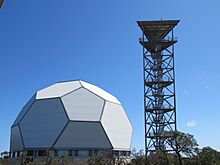Gravity Discovery Centre facts for kids
 |
|
 |
|
| Type | Science museum |
|---|---|
The Gravity Discovery Centre and Observatory is an exciting place to visit in Western Australia. It's a "hands-on" science centre where you can learn about space, Aboriginal culture, and how the world works. You'll find it in the bushland near Gingin, which is north of Perth.
This centre is a not-for-profit place, meaning it's all about education, not making money. It's run by a group called The Gravity Discovery Centre Foundation Board Inc. The land around the centre, with its beautiful bush, is looked after by the Department of Biodiversity Conservation and Attractions.
In 2005, Professor John de Laeter received a special award called the Eureka Prize. He got this award because he created the Gravity Discovery Centre to help people understand science better.
Contents
Fun Science Exhibits
The Discovery Centre
This part of the centre has many interactive displays where you can try things out for yourself.
- Magnetic Cart
You can push a cart with strong magnets down a ramp. Watch how it slows down when it goes over metal plates made of copper or aluminium. These metals are good at carrying electricity. As the magnet moves, it creates electricity in the plates, which slows the cart down. This shows how movement (kinetic energy) can turn into electrical energy.
- OzGrav Model
OzGrav is a short name for a big science group. It stands for the ARC Centre of Excellence for Gravitational Wave Discovery.
- Bernoulli Ball
This display helps you understand Bernoulli's principle. This principle says that when air moves faster, its pressure goes down. This idea was first shared by Daniel Bernoulli in 1738. In this exhibit, a ball floats in the air! If the ball tries to move to the side, the air pushes it back to the middle. The air flowing upwards keeps the ball floating, making it look like it's ignoring gravity.
- Space Capsule
This spinning display is a fun way to see how gravitational forces work.
The Cosmology Gallery
This gallery has a huge dome roof, about 20 metres (66 feet) wide. It's all about the universe!
- NIOBE
This was the first machine in the southern hemisphere built to look for gravitational waves. Gravitational waves are like ripples in space and time, caused by huge events like the Big Bang or black holes crashing together. Scientists started looking for these waves in the 1990s. NIOBE was one of five detectors around the world. It used a special bar made of niobium. Professor David Blair and his team at UWA developed it. It started working in 1993 after many years of hard work. This experiment helped scientists learn a lot and led to even better detectors being built later.
- Timeline of the Universe
In the Cosmology Gallery, you can walk through a timeline that tells the story of the universe. It starts from the Big Bang and goes all the way to today. You'll see how Earth developed and changed over billions of years. There are stories and even real fossils to look at. This display makes you think about your place in the vast universe.
- Penrose Floor
This floor shows a special type of pattern called Penrose tiles. A mathematician named Roger Penrose found a way to tile a floor without repeating the pattern in a simple way. He used shapes like stars, boats, and diamonds, along with rules for how they fit together.
- Astrophotography
- The Australian Shaman Exhibition
This exhibition shows how Indigenous Australians have always had a deep connection to the night sky. You can see many artworks that tell the stories they used to explain what they saw in the stars.
- Southern Cross Cosmos Centre
This is where the GDC Observatory is located.
- The Zadko Telescope
This is a special robotic telescope that can look at objects in space.
The Solar System Walk
The Solar System Walk is a fun way to understand how big our Solar System really is. It's a 1-kilometre (0.6-mile) path through the bushland. The walk starts at the Sun and then you follow the path to see models of the planets and their moons. They are placed at the correct scaled distances from the Sun. Each planet has information plaques to teach you more. The walk ends at Pluto, which is now known as a dwarf planet.
To help you see them better, the models of the planets and moons are made 200 times bigger than they would be on this scale. For example, on this walk, Earth would normally be the size of a peppercorn, and Jupiter would be almost the size of a golf ball. This walk helps you truly understand the huge sizes and distances in space.
While you walk, you might even see some kangaroos that live at the centre! In late winter and spring, the area is full of colourful wildflowers.
Since Pluto is now a "dwarf planet," you can find a replica of Pluto in a special "coffin" display inside the main exhibition area.
Biodiversity Gallery
In the Biodiversity Gallery, you can learn about the plants and animals that live in the local area. The south-west of Australia is a very special place because it has many unique species that are found nowhere else. Some of these plants and animals are now endangered. This gallery celebrates the amazing variety of life in the area. You can see insect specimens, like a native bee, preserved in resin and view them under a microscope. There are also samples of local wildflowers to examine.
Biodiversity Walks are also offered around the site, often with a guide. These walks let you see many different plant species in a short time. You can even see very old paperbark trees (Melaleuca sp.) near the Leaning Tower, some of which are 800 to 1000 years old!
The bushland around the Gravity Discovery Centre is in its natural state, just as it has been for thousands of years. Every spring, the wildflowers put on a beautiful, colourful show. The bright orange-yellow Morrison shrubs (Verticordia nitens) bloom from November to mid-January. But you can find many other plants and animals there all year round.
The Leaning Tower of Gingin
The Leaning Tower of Gingin is a special steel tower, 45 metres (148 feet) tall. It was built so visitors can try out experiments like those done by Galileo Galilei. You can climb the 222 steps to the top and drop water-filled balloons through chutes. The tower leans at a 15-degree angle and is held firmly in place by 180 tons of concrete. This drop tower is also used by popular YouTube channels like "How Ridiculous" and "Mark Rober" for their various drop tests.
Images for kids










